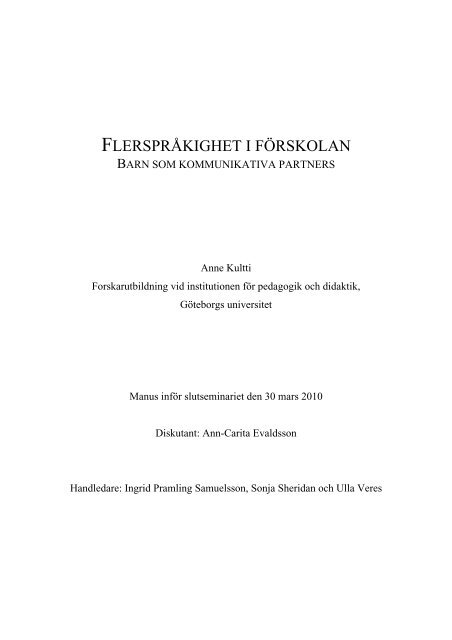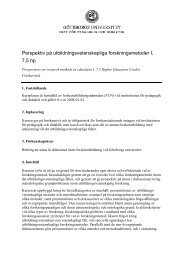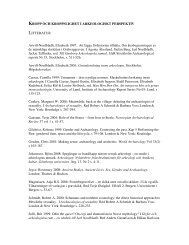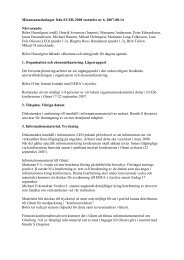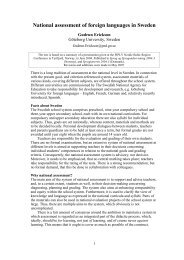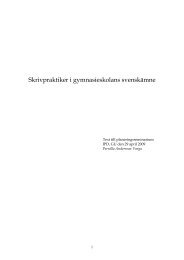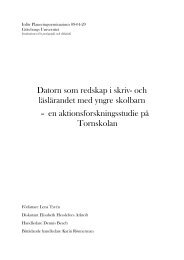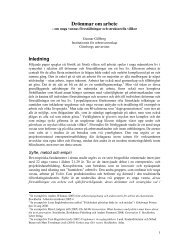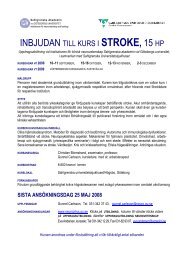flerspråkighet i förskolan - Institutionen för pedagogik och didaktik ...
flerspråkighet i förskolan - Institutionen för pedagogik och didaktik ...
flerspråkighet i förskolan - Institutionen för pedagogik och didaktik ...
Create successful ePaper yourself
Turn your PDF publications into a flip-book with our unique Google optimized e-Paper software.
FLERSPRÅKIGHET I FÖRSKOLAN<br />
BARN SOM KOMMUNIKATIVA PARTNERS<br />
Anne Kultti<br />
Forskarutbildning vid institutionen <strong>för</strong> <strong>pedagogik</strong> <strong>och</strong> <strong>didaktik</strong>,<br />
Göteborgs universitet<br />
Manus in<strong>för</strong> slutseminariet den 30 mars 2010<br />
Diskutant: Ann-Carita Evaldsson<br />
Handledare: Ingrid Pramling Samuelsson, Sonja Sheridan <strong>och</strong> Ulla Veres
INNEHÅLLSFÖRTECKNING<br />
INNEHÅLLSFÖRTECKNING ........................................................................................................................... 2<br />
1. INTRODUKTION .................................................................. FEL! BOKMÄRKET ÄR INTE DEFINIERAT.<br />
BARNS PERSPEKTIV PÅ FLERSPRÅKIGHET I FÖRSKOLAN ...................... FEL! BOKMÄRKET ÄR INTE DEFINIERAT.<br />
AVHANDLINGENS DISPOSITION ........................................................... FEL! BOKMÄRKET ÄR INTE DEFINIERAT.<br />
2. ATT ANALYSERA KOMMUNIKATION – ETT SOCIOKULTURELLT PERSPEKTIV............... FEL!<br />
BOKMÄRKET ÄR INTE DEFINIERAT.<br />
UTVECKLING AV SPRÅK I KOMMUNIKATION ....................................... FEL! BOKMÄRKET ÄR INTE DEFINIERAT.<br />
Språk som redskap....................................................................................Fel! Bokmärket är inte definierat.<br />
Kroppsliga handlingar i barns tidiga kommunikation..............................Fel! Bokmärket är inte definierat.<br />
Ord som tecken med betydelse..................................................................Fel! Bokmärket är inte definierat.<br />
KOMMUNIKATION – YTTRANDEN OCH TOLKNINGAR........................... FEL! BOKMÄRKET ÄR INTE DEFINIERAT.<br />
LEDSAGAT DELTAGANDE .................................................................... FEL! BOKMÄRKET ÄR INTE DEFINIERAT.<br />
Den proximala utvecklingszonen..............................................................Fel! Bokmärket är inte definierat.<br />
Stöttning <strong>och</strong> samarbete ...........................................................................Fel! Bokmärket är inte definierat.<br />
STUDIENS ANALYSBEGREPP OCH SYFTE .............................................. FEL! BOKMÄRKET ÄR INTE DEFINIERAT.<br />
Syfte <strong>och</strong> forskningsfrågor........................................................................Fel! Bokmärket är inte definierat.<br />
3. FLERSPRÅKIGHET ............................................................. FEL! BOKMÄRKET ÄR INTE DEFINIERAT.<br />
FLERSPRÅKIGHET I BARNDOMEN......................................................... FEL! BOKMÄRKET ÄR INTE DEFINIERAT.<br />
Flerspråkighet ur olika teoretiska perspektiv...........................................Fel! Bokmärket är inte definierat.<br />
Relation mellan <strong>för</strong>sta- <strong>och</strong> andraspråk...................................................Fel! Bokmärket är inte definierat.<br />
Modersmål................................................................................................Fel! Bokmärket är inte definierat.<br />
Barns språkutveckling ..............................................................................Fel! Bokmärket är inte definierat.<br />
Pragmatisk utveckling ..............................................................................Fel! Bokmärket är inte definierat.<br />
Sammanfattning av inramningen..............................................................Fel! Bokmärket är inte definierat.<br />
BARNS KOMMUNIKATIVA STRATEGIER ............................................... FEL! BOKMÄRKET ÄR INTE DEFINIERAT.<br />
Kodväxling................................................................................................Fel! Bokmärket är inte definierat.<br />
Ålder <strong>och</strong> motivation ................................................................................Fel! Bokmärket är inte definierat.<br />
Upprepning...............................................................................................Fel! Bokmärket är inte definierat.<br />
BARN LÄR SPRÅK AV VARANDRA........................................................ FEL! BOKMÄRKET ÄR INTE DEFINIERAT.<br />
AVSLUTANDE REFLEKTION ................................................................. FEL! BOKMÄRKET ÄR INTE DEFINIERAT.<br />
4. FÖRSKOLEKONTEXT......................................................... FEL! BOKMÄRKET ÄR INTE DEFINIERAT.<br />
FÖRSKOLAN SOM INSTITUTIONELL PRAKTIK ....................................... FEL! BOKMÄRKET ÄR INTE DEFINIERAT.<br />
Yngre barn i <strong><strong>för</strong>skolan</strong>..............................................................................Fel! Bokmärket är inte definierat.<br />
Förskolans lärandemiljö...........................................................................Fel! Bokmärket är inte definierat.<br />
LÄRARES FÖRHÅLLNINGSSÄTT TILL SPRÅKLIG MÅNGFALD I FÖRSKOLAN .................FEL! BOKMÄRKET ÄR INTE<br />
DEFINIERAT.<br />
KOMMUNIKATION I BARNS SAMSPEL................................................... FEL! BOKMÄRKET ÄR INTE DEFINIERAT.<br />
Samvarokompetens ...................................................................................Fel! Bokmärket är inte definierat.<br />
Kamratkultur ............................................................................................Fel! Bokmärket är inte definierat.<br />
LEK SOM KOMMUNIKATIV PRAKTIK .................................................... FEL! BOKMÄRKET ÄR INTE DEFINIERAT.<br />
Utveckling av lek ......................................................................................Fel! Bokmärket är inte definierat.<br />
AVSLUTANDE REFLEKTION ................................................................. FEL! BOKMÄRKET ÄR INTE DEFINIERAT.<br />
5. METOD ................................................................................... FEL! BOKMÄRKET ÄR INTE DEFINIERAT.<br />
KONTEXTEN FÖR STUDIEN OCH URVALET ........................................... FEL! BOKMÄRKET ÄR INTE DEFINIERAT.<br />
Deltagande barn.......................................................................................Fel! Bokmärket är inte definierat.<br />
VIDEOINSPELNINGAR AV BARNS KOMMUNIKATION ............................ FEL! BOKMÄRKET ÄR INTE DEFINIERAT.<br />
Videoinspelningar i <strong>för</strong>studien .................................................................Fel! Bokmärket är inte definierat.
Dataproduktionen i studien ......................................................................Fel! Bokmärket är inte definierat.<br />
FRÅN FILM TILL TEXT.......................................................................... FEL! BOKMÄRKET ÄR INTE DEFINIERAT.<br />
Analys av barns interaktion i studien .......................................................Fel! Bokmärket är inte definierat.<br />
Att presentera <strong>och</strong> kommunicera studiens resultat...................................Fel! Bokmärket är inte definierat.<br />
FORSKNINGSETISKA ÖVERVÄGANDEN................................................. FEL! BOKMÄRKET ÄR INTE DEFINIERAT.<br />
METODOLOGISK REFLEKTION ............................................................. FEL! BOKMÄRKET ÄR INTE DEFINIERAT.<br />
6. KOMMUNIKATIVA MÖTEN MELLAN BARN I FÖRSKOLAN ........... FEL! BOKMÄRKET ÄR INTE<br />
DEFINIERAT.<br />
MELLAN FÖRSKOLEAKTIVITETER........................................................ FEL! BOKMÄRKET ÄR INTE DEFINIERAT.<br />
I LEKSITUATIONER .............................................................................. FEL! BOKMÄRKET ÄR INTE DEFINIERAT.<br />
SAMMANFATTNING - MÅNGFALDEN AV KOMMUNIKATIVA MÖTEN MELLAN BARN ...FEL! BOKMÄRKET ÄR INTE<br />
DEFINIERAT.<br />
7. VAL AV SPRÅK VID MÅLTID OCH LEKSITUATIONER ..................... FEL! BOKMÄRKET ÄR INTE<br />
DEFINIERAT.<br />
SVENSKA VID MÅLTIDSSITUATIONER .................................................. FEL! BOKMÄRKET ÄR INTE DEFINIERAT.<br />
KODVÄXLING VID LEKSITUATIONER ................................................... FEL! BOKMÄRKET ÄR INTE DEFINIERAT.<br />
SAMSPEL MED BARN MED OLIKA MODERSMÅL.................................... FEL! BOKMÄRKET ÄR INTE DEFINIERAT.<br />
SAMMANFATTNING - SAMMANHANGET HAR INVERKAN PÅ ANVÄNDNING AV TVÅ SPRÅK FEL! BOKMÄRKET ÄR<br />
INTE DEFINIERAT.<br />
8. KOMMUNIKATION ÖVER TID......................................... FEL! BOKMÄRKET ÄR INTE DEFINIERAT.<br />
AUGUSTI ............................................................................................. FEL! BOKMÄRKET ÄR INTE DEFINIERAT.<br />
SEPTEMBER......................................................................................... FEL! BOKMÄRKET ÄR INTE DEFINIERAT.<br />
OKTOBER ............................................................................................ FEL! BOKMÄRKET ÄR INTE DEFINIERAT.<br />
NOVEMBER ......................................................................................... FEL! BOKMÄRKET ÄR INTE DEFINIERAT.<br />
DECEMBER.......................................................................................... FEL! BOKMÄRKET ÄR INTE DEFINIERAT.<br />
JANUARI.............................................................................................. FEL! BOKMÄRKET ÄR INTE DEFINIERAT.<br />
SAMMANFATTNING - FLEXIBILITET I MÖJLIGHETER TILL KOMMUNIKATION I FÖRSKOLAN FEL! BOKMÄRKET ÄR<br />
INTE DEFINIERAT.<br />
9. UTVIDGNING AV LEKAR GENOM SAMARBETE........ FEL! BOKMÄRKET ÄR INTE DEFINIERAT.<br />
FRÅN ENSTAKA HANDLINGAR TILL EN HÄNDELSEKEDJA..................... FEL! BOKMÄRKET ÄR INTE DEFINIERAT.<br />
FÖRHANDLINGAR FÖR FORTSATT LEK ................................................. FEL! BOKMÄRKET ÄR INTE DEFINIERAT.<br />
SAMMANFATTNING - VARAKTIGHET I KOMMUNIKATION .................... FEL! BOKMÄRKET ÄR INTE DEFINIERAT.<br />
10. DISKUSSION........................................................................ FEL! BOKMÄRKET ÄR INTE DEFINIERAT.<br />
FLERSPRÅKIGHET I FÖRSKOLAN – INITIATIVTAGANDE, RELATIONER MELLAN BARN OCH TILLFÄLLEN TILL<br />
SAMSPEL ............................................................................................. FEL! BOKMÄRKET ÄR INTE DEFINIERAT.<br />
BARN SOM KOMMUNIKATIVA PARTNERS............................................. FEL! BOKMÄRKET ÄR INTE DEFINIERAT.<br />
Kombinationer av handlingar ..................................................................Fel! Bokmärket är inte definierat.<br />
Barn som kommunikativa partners i olika sammanhang..........................Fel! Bokmärket är inte definierat.<br />
Uppmärksamhet mot det gemensamma ....................................................Fel! Bokmärket är inte definierat.<br />
Utveckling som kommunikativa partners i interaktion med andra barn...Fel! Bokmärket är inte definierat.<br />
STÖTTNING I SAMARBETE MELLAN BARN............................................ FEL! BOKMÄRKET ÄR INTE DEFINIERAT.<br />
Barngrupp <strong>och</strong> vänskap............................................................................Fel! Bokmärket är inte definierat.<br />
Upprepning av form <strong>och</strong> samtalstema......................................................Fel! Bokmärket är inte definierat.<br />
Samarbete genom lek................................................................................Fel! Bokmärket är inte definierat.<br />
MILJÖN SOM INTERAKTIONELL UTMANING ......................................... FEL! BOKMÄRKET ÄR INTE DEFINIERAT.<br />
METODDISKUSSION OCH FORTSATT FORSKNING ................................. FEL! BOKMÄRKET ÄR INTE DEFINIERAT.<br />
STUDIENS BIDRAG TILL FORSKNINGSFÄLTET....................................... FEL! BOKMÄRKET ÄR INTE DEFINIERAT.<br />
Pedagogiska konsekvenser .......................................................................Fel! Bokmärket är inte definierat.<br />
11. SUMMARY ..................................................................................................................................................... 1<br />
BACKGROUND..................................................................................................................................................... 5<br />
Theoretical framework .................................................................................................................................. 5<br />
Research of multilingualism .......................................................................................................................... 8<br />
Research in the preschool context ................................................................................................................. 9<br />
RESEARCH METHOD .......................................................................................................................................... 10
Selection and context................................................................................................................................... 10<br />
Data production and analysis...................................................................................................................... 11<br />
Ethical and methodological considerations ................................................................................................ 11<br />
FINDINGS AND DISCUSSION ............................................................................................................................... 12<br />
Multilingualism in preschools – initiative, relationship and opportunity.................................................... 12<br />
12. REFERENSER.............................................................................................................................................. 14
11. SUMMARY<br />
Background<br />
There are increasing numbers of children who communicate in more than one language in our<br />
society. They grow up and become a part of a society in which people predominately share<br />
language, knowledge, culture and ethnic values. In Sweden, the majority of children enter<br />
preschool between their first and second year. There are 13,000 two-year-olds in preschool<br />
who have a first language other than Swedish (Skolverket, 2009). In preschool, these children<br />
will have interactions with many other children at a time when their verbal communication is<br />
developing. The aim of this study is to investigate how multilingualism appears in the<br />
communications between children during their early years at preschool while parents of these<br />
children communicate with them in one or more languages other than Swedish. In other<br />
words, some children will have communicative partners who may have other languages in<br />
these early years. The focus of the research is on how multilingualism is expressed in<br />
children’s everyday life in preschool.<br />
Theoretical framework<br />
The theoretical approach in the study is a socio-cultural perspective on learning and<br />
development based on the theory of Lev Vygotskij (1934/2007). Children’s experiences and<br />
knowledge are related to the environments in which they participate. The focus is on the<br />
dialectic between young children’s communicative actions and preschool as a learning<br />
environment.<br />
The theoretical discussion focuses on understanding and analysing young multilingual<br />
children’s communication in preschool that frames their interactions. According to Rogoff<br />
(1990) children adopt the frames of the preschool at the same time as they contribute to create<br />
them. This position will be discussed in terms of: a) language as a tool for interaction, b)<br />
communication as a social act, and c) collaboration.<br />
Communication is crucial to learning where language is used as a tool to steer and plan<br />
actions. (Rogoff, 1990, 2003; Säljö, 2000; Vygotsky, 1934/2007). Vygotsky’s theory is built
on an analysis of language as a tool for learning in which learning, also leads to changes in<br />
communicative competence. Young children’s non-verbal actions are essential in creating<br />
intersubjectivity and coordinating verbal action (Nelson, 2007; Ninio & Snow, 1996,<br />
Vygotsky, 1978). In a socio-cultural driven analysis of multilingualism in preschool, the use<br />
of Swedish words is not a presumption for communication. Both linguistic and social aspects<br />
of communication are included in the analysis. Physical, social and cultural opportunities<br />
impact on what is intended and understood in the communication, that is, what is desirable<br />
and allowable in the context (Säljö, 2000).<br />
Communication, as a social act, includes how something is said and how it is interpreted<br />
(Linell, 2001; Säljö, 2000). In the process of creating knowledge “the actions of one have<br />
meaning only with respect to those of the other” (Rogoff, 1990, p. 190). Rogoff continues that<br />
“the mutual engagement of children and their companions provides support for development.”<br />
Neither the individual nor the social context can be analysed without consideration of the<br />
other. This indicates a dialectical perspective on language, in that multilingualism is<br />
expressed and created in the interaction.<br />
According to Nelson (1996) children learn to identify the relevance of the word in context.<br />
“Discourse can not provide meaning, but only clues to meaning … The process of use before<br />
meaning (within similar contexts) may be engaged by the child, from which meaning from use<br />
gradually accrues.” (s. 145). For example, having lunch in children’s communication needs to<br />
be interpreted in the context of within or outside a play activity. Meaning is appropriated<br />
through participation in the activities of preschool.<br />
The situated nature of meaning-making can be understood in terms of guided participation,<br />
scaffolding and collaboration (Bruner, 1978; Rogoff, 1990; 2003; Siraj-Blatchford, 2007;<br />
2009a). Rogoff’s tem guided participation is based on Vygotsky’s (1978) concept of zone of<br />
proximal development (ZPD) that focuses on children’s capabilities and the knowledge<br />
available to the interaction. ZPD and scaffolding has been interpreted in various ways but<br />
mainly used in learning contexts to study children’s cognitive development through<br />
interactions that are scaffolded by adults, as more expert partners in the interaction.<br />
When studying young children’s communication, Rogoff’s (1990) distinction between<br />
collaboration and acting collectively can be discussed. Collaboration refers to shared
meaning-making and engagement between two or more individuals to extend their<br />
communication (e.g., Siraj-Blatchford, 2009a). In acting collectively, attention is not focused<br />
on doing something together. For example, children may be in the same room; they might be<br />
sitting next to each other and influence each other’s actions. However, they can model on<br />
each other’s actions and ideas without extending their communication.<br />
Rogoff’s (2003) concept of the three lenses - individual, interactional and cultural as a focus<br />
of analysis is also useful. It can be used to study multilingualism in the communications<br />
between young children in preschool.<br />
Analysis through the individual lens focuses on multilingual children as communicative<br />
partners in preschool. This includes aspects of their pragmatic language development, like the<br />
strategies used to initiate and maintain a topic of communication with others. Some questions<br />
to explore would be: How do children clarify their acts with words? Which tools are available<br />
and which are used? How is a topic of communication attended to?<br />
Analysis through the interactional lens focuses on scaffolding and its meaning for<br />
collaboration and extending communication. Communication, utterances and interpretations,<br />
include intersubjectivity, taking the others’ perspective and dialogue. A question to explore is:<br />
What does scaffolding mean in communication between young children who have different<br />
spoken languages for communication?<br />
Analysis through the cultural lens in this study is through the institutional context. The<br />
exploration through this lens focuses on the institutional practices in the preschool<br />
environment and the activities and ways of talk, as the frame for children’s communication.<br />
Within this theoretical approach, children are seen as a part of the culture of meaning that<br />
children both reproduce and produce in their interactions. Children will both learn useful<br />
ways of communication in preschool and, as well, they will create shared experiences when<br />
participating in activities, regardless of their different language skills and knowledge. The<br />
question is: What opportunities are offered to children to create new ways to express<br />
themselves and extend their communications?
The aim is to study is to explore how multilingualism is expressed in communication between<br />
young children in preschool through the research questions:<br />
- How do children present as communicative partners in interaction with each other?<br />
- How do children scaffold each other’s communications on a topic?<br />
- How does the environment present interactive challenges?<br />
Research of multilingualism<br />
Research of multilingualism is discussed through three themes: a) multilingualism in<br />
childhood; b) multilingual children’s strategies for language use; and c) language learning in<br />
peer interaction.<br />
Multilingualism is part of a large research field on language development. The focus in<br />
theories of language learning is on cognitive aspects (Abrahamsson, 2009; Atkinson, 2002).<br />
Research questions relate to the relations between the languages, the age of learning a second<br />
language, and the role of the first language in learning a new language. Young children’s<br />
acquisition of a second language uses such terms as simultaneously bilingualism (i.e., learning<br />
two languages before the age of three at home), and additive multilingualism (i.e., how one<br />
language contributes to learning another language in different contexts) (Håkansson, 2003;<br />
Lindberg, 2002). In this study, simultaneously multilingualism in different contexts is a<br />
suitable term, if using these definitions. There are also studies that include the social and<br />
contextual aspects of learning a second language (Atkinson, 2002; Thomas & Collier, 1997).<br />
This study takes as a starting point pragmatic language development, that is, how children<br />
learn to use language in different situations (Ninio & Snow, 1996).<br />
Code-switching as a multilingual strategy has also recently been studied. This focus on codeswitching<br />
in context has been studied in multilingual environments in preschools and schools<br />
(Björk-Willén, 2006; Cromdal, 2000). The results indicate code-switching use for social<br />
purposes. Studies of repetition as one communicative strategy in interactions between<br />
preschool children indicate, for example, that self-repetition increases children’s participation<br />
while repetitions by others extend communication and cognitive development (Rydland &<br />
Grøver Aukrust, 2005). There are also studies indicating that second language learning differs<br />
according to the age of the child and a research focus on for younger children is needed in this<br />
area of research (Philp & Dushesne, 2008).
A third theme in the study of language learning through peer interaction explores the issue of<br />
expert and novice with different languages. Studies of peer talk show the importance of<br />
communication between children for pragmatic language development (Blum-Kulka et al.,<br />
2004; Katz, 2004). The group balance, in terms of first and second language speakers, and<br />
their level of collaboration are known to be important (Blum-Kulka & Snow, 2004; Fassler,<br />
1998a; Grøver Aukrust, 2004; Katz, 2004; Nicolopoulou, 2002). Addressing both the<br />
language and social aspects of children’s second language learning is essential (Philp et al,<br />
2008b). In other words, learning through peer interaction, despite differences in language, is<br />
possible. Yet, systematic studies within this area are rare (Katz, 2004).<br />
Research in the preschool context<br />
Within research in the preschool context that is focussed on multilingualism and children’s<br />
communication, there are four themes: a) institutional practice, b) the teacher’s approach, c)<br />
young children’s stage of language development, and d) play as a social practice.<br />
The structure, intentions of the curriculum and variations in content create the institutional<br />
practices which shape the perspectives on young children in preschool and their learning.<br />
According to the Curriculum for the Preschool (Skolverket, 2006) each child should be given<br />
opportunities for developing their language and culture. There are longitudinal studies of<br />
preschool learning environments showing how they contribute to children’s language and<br />
communication skills and compensate for the home environment (Sylva et al., 1999, 2004).<br />
However, multilingualism is randomly mentioned.<br />
Teachers are essential to the environment for learning (Sylva et al., 1999, 2004; Sheridan et<br />
al., 2009). In this study, the focus is on the teacher’s approach to language diversity in the<br />
preschool group through their language use and the content of their communication. Some<br />
research findings indicate that the learning opportunities in are dependent on children’s ethnic<br />
background rather than their language skills, based on the teacher’s approach to learning<br />
(Johansson, 2003b; Palludan, 2007) and that Swedish has primary legitimacy in preschool<br />
(Axelsson, 2005).<br />
Research on young children’s interactions in preschool focusing on learning, ethical issues<br />
within groups show that children’s desire for peer interactions and to make friends<br />
(Johansson, 1999, 2007; Løkken, 1996; Michélsen, 2005; Sheridan, et al., 2009). Older
children (3-6 years) have been studied focusing on children in interaction, and interactions<br />
within a group of children (Corsaro, 2003, 2005; Sommer, 2005a, 2005b). These approaches<br />
are seen as complementing understanding of multilingualism in interactions between the<br />
young children in this study.<br />
Play as social practice focuses on young children’s learning through play and the development<br />
of play (Corsaro, 2003; Fleer, ms; Hakkarainen, 2002; Johansson & Pramling Samuelsson,<br />
2006; Sawyer, 1997; Vygotsky, 1995). Taking others’ perspectives, fantasy and extended<br />
communication and play scripts are seen as important aspects of children’s learning and<br />
development through play.<br />
Research method<br />
Multilingualism in this research in relation to interactions and context is studied through the<br />
experiences of ten multilingual children in a preschool context. The focus is on the<br />
interactions between children through three lenses: individual, interactional and institutional<br />
as the tools for analysis (Rogoff, 2003).<br />
Selection and context<br />
The fieldwork was carried out in eight preschools over a six-month period. The children and<br />
the preschools were participants in Children’s Early Learning, a cross-sectional study of<br />
preschool as a learning environment (Sheridan et al., 2009). Data was produced through video<br />
recordings of ten children (1.7 - 2.11 years) whose first language was other than Swedish<br />
(Bosnian, Bulgarian, English, Finnish, Fulah, German, Kurdish, Krio, Norwegian, Persian,<br />
Tigrinya, Temne).<br />
The preschools were located in five different socioeconomic areas. There was diversity in<br />
children’s language backgrounds across the preschools. Six of the preschools had groups for<br />
toddlers and two had mixed age groups for children aged one to five years. The preschool in<br />
Sweden provides whole day care. Children participate in indoor- and outdoor activities in<br />
large or small groups for such activities as play, singing and reading stories. The meals<br />
(breakfast, lunch and snacks) are provided by the preschool. During meals, children and<br />
teachers sit together, often in small groups. After lunch, children take a nap.
Data production and analysis<br />
Video recording is a common method used in early childhood research to focus on children’s<br />
actions and interaction (Heikkilä & Sahlström, 2003; Sheridan et al., 2009). There are benefits<br />
and limitations to video recording as a method for producing data on young children’s<br />
interactions. For example, it opens up possibilities to produce data close to children’s actual<br />
communications and, in this way, includes young children in the research. Rich data can be<br />
captured of communications but also video may leave out some aspects beyond the camera<br />
view.<br />
The data production was a total 47 hours of recordings of communicative situations in which<br />
the children participated with their peers and with teachers. A data program, Transana<br />
(retrieved 01-12-06) was used to process the video recordings visually and with written<br />
transcriptions simultaneously. The intention was to maintain extensive details and capture the<br />
wholeness of the situations in order to reduce neither the focus on children nor the focus on<br />
the whole context. This is discussed with reference to Blum-Kulka’s (2004) argument on the<br />
combinations of methodologies.<br />
The analyses presented of interactions between children are based on approximately five<br />
hours of video data with 56 sequences. The sequences are from one minute to thirty minutes<br />
in length. The teachers are included only when the children were asking for help in any<br />
situation. In the analyses, play situations refer to situations in which the children had an<br />
opportunity to choose what they wanted to do and with whom they wanted to interact.<br />
Mealtime is another situation which appears in the analyses.<br />
Ethical and methodological considerations<br />
Ethical considerations took account of the ethical guidelines of the Swedish Research Council<br />
for the Humanities-Social sciences (Vetenskapsrådet, retrieved 07-10-08). Ethical standpoints<br />
for using video information and obtaining parental approval are not enough in conducting<br />
research on and with young children (Haudrup, 2004). For example, children’s<br />
communicative signs of disapproval during the video process, as well as situations which<br />
might be interpreted as rule violations need to be respected. Methodological reflections of the<br />
empirical study considered the researcher as an observer producing representative data and<br />
analysis of children’s actions. The researcher’s intention to stay in the background does not<br />
eliminate the physical presence in the room.
Findings and discussion<br />
Four result chapters are structured around the preschool activities in which interactions<br />
between children occurred. The findings of these chapters are summarised below.<br />
The variety of communicative actions and topics of communications in meetings of children<br />
was evident in their. Only Swedish is used. The communications occur in the interactions in<br />
activities within play situations. There is mutuality in the interactions according to individual<br />
children’s level of communicative skills and the communicative skills of the group.<br />
The use of both languages by children with the same first language depended on the nature of<br />
the preschool activities. Mealtime was a site for practice in which Swedish was spoken while<br />
code-switching was used in other play situations. The context, situation and individuals<br />
involved had an impact on the language usage.<br />
Within participation in interaction over time between peers with different languages, then<br />
there needed to be flexibility in opportunities to communicate. Flexibility refers to the social<br />
and verbal aspects of communication in being able to “change” topics and through the<br />
variation of playmates.<br />
Children with different first languages extended their collaborative play through scaffolding<br />
by other children. The children maintained their play that at the same time offered them<br />
opportunity to learn verbal and social skills. Engagement, perspective-taking and<br />
collaboration characterised the communications. Continuous maintenance of play characters<br />
within activities seems essential to extend the play. When children had experience of the play<br />
themes and roles, the possibility of repeating each other’s actions was possible when there<br />
was time and room for play, and toys and supportive teachers were available.<br />
Multilingualism in preschools – initiative, relationship between children and<br />
opportunity for interaction<br />
The integrated focus of analysis - individual, interactional and institutional, on<br />
communication creates knowledge about multilingual children’s communicative strategies,<br />
collaboration and social practices in context. Swedish is used by the children as a common<br />
language in the preschools. In that context, children seem to use the languages functionally<br />
from a very early age. However, they can switch languages to use their first language with
people whom they know understand that language. They show this competence in<br />
communication exchanges in social situations. In other words, as a resource for learning, the<br />
first language demands that other children with knowledge of the same language is required.<br />
Only one of the eight preschools included in the study met this demand.<br />
The findings indicate that multilingualism in an institutional context such as the preschool<br />
environment takes account of children using the Swedish language during participation in<br />
activities. This way of learning a new language has similarities with immersion programs.<br />
However, other children and teachers may only have knowledge of the common language.<br />
Children’s knowledge of the social practices mediates relevant content of communications<br />
and the ways to communicate. In other words, children both participate and create social<br />
practices in preschool through their communications (Rogoff, 1990, 2003; Säljö, 2000;<br />
Vygotsky, 1934/2007). This implies that children learning Swedish in preschool during the<br />
early years are given possibilities to develop two first languages.<br />
The findings indicate that multilingualism in children’s communication in preschool is a<br />
coordination of three dimensions: a) children’s interest in the interaction and their initiative;<br />
b) the relationships between children; and c) the possibilities (time and support) for<br />
interaction. These dimensions are conditions for children’s participation in interactions,<br />
through which possibilities for learning and development are created.<br />
The main findings are discussed in terms of the communications between children with the<br />
same and a different first language; the contextual influences; the known topics; the transition<br />
between activities; the level of social and verbal skills; and the evidence for scaffolding and<br />
collaboration in play.<br />
In summary, mutuality and diversity can used to describe multilingualism in communication<br />
between young children in preschool. The social and situated nature, from a methodological<br />
standpoint, implies that multilingualism in preschool becomes invisible. Multilingualism not<br />
only as an individual skill but also as a participatory process in interactions with others is<br />
evident. Changing the perspective of multilingualism as an individual attribute to<br />
multilingualism as a participatory process contributes to extended knowledge about the nature<br />
of the communicative development of young children.
12. REFERENSER<br />
Abrahamsson, N. (2009). Andraspråksinlärning. Lund: Studentlitteratur.<br />
Abrahamsson, N., & Hyltenstam, K. (2004). Mognadsbegränsningar <strong>och</strong> den kritiska perioden<br />
<strong>för</strong> andraspråksinlärning. I K. Hyltenstam & I. Lindberg (Red), Svenska som andraspråk<br />
– i forskning, undervisning <strong>och</strong> samhälle. (s 221-258). Lund: Studentlitteratur.<br />
Abrahamsson, N., & Hyltenstam, K. (2006). Inlärningsålder <strong>och</strong> uppfattad inföddhet i<br />
andraspråket. Nordand 1(1), 9-35.<br />
Ammar, A., & Spada, N. (2006). One size fits all? Recasts, prompts, and L2 learning. SSLA,<br />
28, 543-574.<br />
Angelova, M., Gunawardena, D. & Volk, D. (2006). Peer teaching and learning: coconstructing<br />
language in a dual language first grade. Language and education, 20(3),<br />
173-190.<br />
Arnqvist, A. (1993). Barns språkutveckling. Lund: Studentlitteratur.<br />
Atkinson, D. (2002). Toward a Sociocognitive Approach to Second Language Acquisition.<br />
The Modern Language Journal. 86:4, 525-545.<br />
Auer, P. (1995). The pragmatics of code-switching. I L. Milroy & P. Muysken (Red.),<br />
One speaker, two languages: cross-disciplinary perspectives on code-switching. (s 115-<br />
135). Cambridge: Cambridge Univ. Press.<br />
Aukrust, V. (2002). What did you do in school today? Speech genres and tellability in<br />
multiparty family mealtime conversations in two cultures. I S. Blum-Kulka & C. Snow<br />
(Red.), Talking to adults: the contribution of multiparty discourse to language<br />
acquisition. (s 55-83). Mahwah, N.J.: Lawrence Erlbaum.<br />
Aukrust, V. G., & Snow, C. (1998). Narratives and explanations during mealtime<br />
conversations in Norway and the U.S. Language in Society, 27, 221-246.<br />
Axelsson, M. (2005). Litteracitetsutveckling i Stockholms flerspråkiga <strong>för</strong>skolor. I M.<br />
Axelsson, C. Rosander, & M. Sellgren. (Red.). Stärkta trådar: flerspråkiga barn <strong>och</strong><br />
elever utvecklar språk, litteracitet <strong>och</strong> kunskap: en sammanfattning: utvärdering av<br />
Stockholms stads storstadssatsning - målområde språkutveckling <strong>och</strong> skolresultat.<br />
Spånga: Rinkeby språkforskningsinstitut.<br />
Axelsson, M., Rosander, C., & Sellgren, M. (2005). Stärkta trådar: flerspråkiga barn <strong>och</strong><br />
elever utvecklar språk, litteracitet <strong>och</strong> kunskap: en sammanfattning: utvärdering av<br />
Stockholms stads storstadssatsning - målområde språkutveckling <strong>och</strong> skolresultat.<br />
Spånga: Rinkeby språkforskningsinstitut.<br />
Bae, B. (2004). Dialoger mellom førskolelærer og barn – en beskrivende og fortolkende<br />
studie. Høgskolen i Oslo: Avdeling for lærerutdanning. (HiO-rapport nr 25.) Hämtad<br />
2009-04-02 från www.hio.no.<br />
Björk-Willén, P. (2006). Lära <strong>och</strong> leka med flera språk. Socialt samspel i flerspråkig<br />
<strong>för</strong>skola. Linköping: Linköping Studies in Arts and Science.<br />
Blum-Kulka, S. (1997). Dinner talk: patterns of sociability and socialization in family<br />
discourse. Mahwah, N.J.: Lawrence Erlbaum.<br />
Blum-Kulka, S. (2002). Do you believe that Lot’s wife is blocking the road (to Jericho)?: coconstruction<br />
theories about the world with adults. I S. Blum-Kulka & C. Snow (Red.),<br />
Talking to adults: the contribution of multiparty discourse to language acquisition. (s<br />
85-115). Mahwah, N.J.: Lawrence Erlbaum.
Blum-Kulka, S. (2005). Modes of meaning making in young children’s conversational<br />
storytelling. I J. Thornborrow & J. Coates (Red.), The sociolinguistics of narrative.<br />
Studies in narrative 6. (s 149-170). Amsterdam: John Benjamins.<br />
Blum-Kulka, S., Huck-Taglicht, D., & Avni, H. (2004). The social and discursive spectrum of<br />
peer talk. Discourse studies, 6(3), 307-328.<br />
Blum-Kulka, S., & Snow, C. (2004). Introduction: the potential of peer talk. Discourse<br />
studies, 6(3), 291-306.<br />
Bruner, J. (1978). The Role of Dialogue in Language acquisition. I A. Sinclair, R. Jarvella &<br />
W. Levelt (Red.), The child's conception of language. (s 241-256). Berlin: Springer.<br />
Bruner, J. (1996). The culture of education. (3:e rev upplagan). Cambridge, Mass.: Harvard<br />
University Press.<br />
Bucholtz, M. (2000). The politics of transcription. Journal of Pragmatics 32, 1439-1465.<br />
Budwig, N., Uzgiris, I., & Wertsch, J. (2000). Communication: an arena of development.<br />
Stamford, Conn.: Ablex.<br />
Cekaite, A. (2006). Getting started. Children’s participation and language learning in an L2<br />
classroom. Linköping: Linköping Studies in Arts and Science.<br />
Cekaite, A., & Aronsson, K. (2004). Repetition and joking in children’s second language<br />
conversations: playful recyclings in an immersion classroom. Discourse studies, 6, 373-<br />
392.<br />
Christensen, P. (2004). Children's participation in ethnographic research: Issues of power and<br />
representation. Children & Society, 18, 165 - 176.<br />
Clark, E. V. (2003) First Language Acquisition. Cambridge: Cambridge Univ. Press.<br />
Clifford, R., & Bryant, D. (2003). Multi-State study of Pre-Kindergarten. National Centre for<br />
Early Development & Learning. Chapell Hill: University of North Carolina.<br />
Corsaro, William A. (1985). Friendship and peer culture in the early years. Norwood, N.J.:<br />
Ablex.<br />
Corsaro, W. (2003). We’re friends, right? Inside the kids’culture. Washington, D.C: Joseph<br />
Henry Press.<br />
Corsaro, W. (2005). The sociology of childhood (2:a rev upplagan). California: Sage.<br />
Cromdal, J. (2000). Code-switching for all practical purposes. Bilingual organization of<br />
children’s play. Linköping: Linköping Studies in Arts and Science.<br />
Cromdal, J., & Evaldsson, A-C. (2003). Ett vardagsliv med flera språk. Stockholm: Liber.<br />
Cummins, J. (1981a). Bilingualism and minority language Children. Ontario Institute of<br />
Studies of Education. Toronto: OISE Press.<br />
Cummins, J. (1981b). Age on Arrival and Immigrant second language learning in Canada: A<br />
reassessment. Applied Linguistics, 2, 132-149.<br />
Cummins, J. (1986). Empowering minority students: A framework for intervention. Harvard<br />
Educational Review, 56(1), 18-36.<br />
Cummins, J. (1996). Negotiating identities: Education for empowerment in a diverse society.<br />
Los Angeles, CA: Californian association for bilingual education.<br />
Cummins, J. (2000). Language, power, and pedagogy: Bilingual children in the crossfire.<br />
Clevedon, England: Multilingual Matters.<br />
Danby, S. (2002). The communicative competence of young children. Australian Journal of<br />
Early Childhood, 27(3), 25-31.<br />
Didow, S. M. & Eckerman. C. O. (2001). Toddler Peers: from nonverbal coordinated action to<br />
verbal discourse. Social Development, 10(2), 170-188.<br />
Education & Culture DG. (2008). Education and migration strategies for integrating migrant<br />
children in European schools and societies. European forum for migration studies by the<br />
NESSE network.
Emilson, A. (2008). Det önskvärda barnet. Fostran uttryckt i vardagliga<br />
kommunikationshandlingar mellan lärare <strong>och</strong> barn i <strong><strong>för</strong>skolan</strong>. Göteborg: Acta<br />
Universitatis Gothoburgensis.<br />
Engdahl, I. (2007). Med barnens röst. Ettåringar “berättar” om sin <strong>för</strong>skola.<br />
Licentiatavhandling i barn <strong>och</strong> ungdomsvetenskap. Individ, omvärld <strong>och</strong> lärande.<br />
Forskning nr 40. Stockholm: Lärarhögskolan.<br />
Eriksen Ødegaard, E. (2007). What’s on the teachers’ agenda? Teachers’ didactical projects in<br />
co-narration with very young children. International Journal of Early Childhood, 39(2),<br />
45-64.<br />
Ervin-Tripp, S. M. (1979). Children’s verbal turn-taking. I E. Ochs & B. Schieffelin (Red.),<br />
Developmental pragmatics. (s 391-414). New York: Academic Press. Hämtad 2009-08-<br />
02 från http://socrates.berkeley.edu.<br />
Ervin-Tripp, S. M. (1986). Activity types and the structure of talk in second language<br />
learning. I J. Fishman (Red.), The Fergusonian impact: Papers in honor of the 65th<br />
birthday of C.A. (s 421-435). Ferguson. Berlin: Mouton de Gruyter, vol. 1. Hämtad<br />
2009-08-02 från http://socrates.berkeley.edu.<br />
Fassler, R. (1998a). Room for talk: Peer support for getting into English in an ESL<br />
kindergarten Early Childhood Research Quarterly, 13(3), 379-409.<br />
Fassler, R. (1998b). Let’s do it again! Peer collaboration in an ESL kindergarten. Language<br />
Arts, 75(3), 202–210.<br />
Firth, A., & Wagner, J. (1997). On discourse, communication, and (some) fundamental<br />
concepts in SLA research. The Modern Language Journal, 81(3), 285-300.<br />
Fleer, M. (manus). Early learning and development. Cultural-historical concepts in play. Port<br />
Melbourne: Cambridge Univ. Press.<br />
Genesee, F. (1987). Learning through two languages: studies of immersion and bilingual<br />
education. Cambridge, Mass.: Newbury House.<br />
Gjems, L. (2009). Å samtale seg til kunnskap. Sosiokulturelle teorier om barns læring om<br />
språk og gjennom språk. Bergen: Fagbokforlaget.<br />
Greve, A. (2007). Vennskap mellom små barn i barnehagen. Det utbildningsvitenskaplige<br />
fakultet. Institutt for special<strong>pedagogik</strong>k. Oslo: Universitetet i Oslo.<br />
Grøver Aukrust, V. (2001). Talk-focused talk in preschools – culturally formed socialization<br />
for talk? First Language, 21, 57-82.<br />
Grøver Aukrust, V. (2004). Explanatory discourse in young second language learners’ peer<br />
play. Discourse Studies, 6(3), 393-412.<br />
Grøver Aukrust, V. (2007). Young children acquiring second language vocabulary in<br />
preschool group-time: does amount, diversity, and discourse complexity of teacher talk<br />
matter? Journal of Research in Childhood Education, 22(1), 17-37.<br />
Haglund, B. (2003). Stimulated recall: Några anteckningar om en metod att generera data.<br />
Pedagogisk Forskning i Sverige, 8(3), 145–157.<br />
Hakkarainen, P. (2002). Kehittävä esiopetus ja oppiminen. [Utvecklande <strong>för</strong>skole<strong>pedagogik</strong><br />
<strong>och</strong> lärande.] Jyväskylä: PS-kustannus.<br />
Hakkarainen, P. (2006). Development of motivation in play and narratives. Hämtad 2009-04-<br />
20 från http://dev.papers.ierg.net/papers/Hakkarainen_185.pdf.<br />
Hakkarainen, P., & Bredikyte, M. (2008). The zone of proximal development in play and<br />
learning. Cultural-historical Psychology, 4, 2-11.<br />
Hakkarainen, P. Personlig kommunikation 2008-04-20 vid doktorandkurs, Göteborgs<br />
universitet.<br />
Hakuta, K., & Cancino, H. (1997). Trends in second language acquisition research. Harvard<br />
Educational Review, 47, 294-316.
Halldén, G. (2003). Barnperspektiv som ideologiskt <strong>och</strong>/eller metodologiskt begrepp. I E.<br />
Johansson & I. Pramling Samuelsson (Red.), Barns perspektiv <strong>och</strong> barnperspektiv i<br />
pedagogisk forskning <strong>och</strong> praxis. Temanummer Pedagogisk forskning i Sverige, 8(1-2),<br />
12-23.<br />
Halldén, G. (2007). (Red.) Den moderna barndomen <strong>och</strong> barns vardagsliv. Stockholm:<br />
Carlssons <strong>för</strong>lag.<br />
Hamo, M., Blum-Kulka, S., & Hacohen, G. (2004). From observation to transcription and<br />
back: theory, practice and interpretation in the analysis of children’s naturally occurring<br />
discourse. Research on Language and Social Interaction, 37(1), 71-92.<br />
Haudrup, P. (2004). Children’s participation in ethnographic research: issues of power and<br />
representation. Children & Society, 18, 165-176.<br />
Heath, C., & Luff, P. (1992). Explicating face to face interaction. I N. Gilbert (Red.),<br />
Researching social life (s 306-327). London: Age.<br />
Heikkilä, M., & Sahlström, F. (2003). Om användning av videoinspelning i fältarbete. I E.<br />
Johansson & I. Pramling Samuelsson (Red.), Barns perspektiv <strong>och</strong> barnperspektiv i<br />
pedagogisk forskning <strong>och</strong> praxis. Temanummer Pedagogisk forskning i Sverige, 8(1-2),<br />
24-41.<br />
Hendrick, H. (2000). The child as a social actor in historical sources: problems of<br />
identification and interpretation. I P. Christensen & A. James (Red.), Research with<br />
children: perspectives and practices. London: Falmer Press.<br />
High/Scope: Hämtad 09-01-15 från www.highscope.org.<br />
Hundeide, K. (2001). Vägledande samspel: handbok till ICDP, International Child<br />
Development Programs (1:a rev. upplagan.). Stockholm: Rädda barnen: ICDP Sweden.<br />
Hundeide, K. (2006). Sociokulturella ramar <strong>för</strong> barns utveckling – barns livsvärldar. Lund:<br />
Studentlitteratur.<br />
Hyltenstam, K., & Tuomela, V. (1996). Hemspråksundervisning. I K. Hyltenstam (Red.)<br />
Tvåspråkighet med <strong>för</strong>hinder? Invandrar- <strong>och</strong> minoritetsundervisning i Sverige. (s 9-<br />
109). Lund: Studentlitteratur.<br />
Håkansson, G. (1998). Språkinlärning hos barn. Lund: Studentlitteratur.<br />
Håkansson, G. (2003). Tvåspråkighet hos barn i Sverige. Lund: Studentlitteratur.<br />
Johansson, E. (1999). Etik i små barns värld. Om värden <strong>och</strong> normer bland de yngsta barnen<br />
i <strong><strong>för</strong>skolan</strong>. Göteborg: Acta Universitatis Gothoburgensis.<br />
Johansson, E. (2003a). Att närma sig barns perspektiv. I E. Johansson & I. Pramling<br />
Samuelsson (Red.), Barns perspektiv <strong>och</strong> barnperspektiv i pedagogisk forskning <strong>och</strong><br />
praxis. Temanummer Pedagogisk forskning i Sverige, 8(1-2), 42-57.<br />
Johansson, E. (2003b). Möten <strong>för</strong> lärande. Pedagogisk verksamhet <strong>för</strong> de yngsta barnen i<br />
<strong><strong>för</strong>skolan</strong>. Stockholm: Skolverket.<br />
Johansson, E. (2007). Etiska överenskommelser i <strong>för</strong>skolebarns världar. Göteborg: Acta<br />
Universitatis Gothoburgensis.<br />
Johansson, E. (2009). Barns samspel. I S. Sheridan, I. Pramling Samuelsson & E. Johansson<br />
(Red), Barns tidiga lärande. (s 185-214). Göteborg: Acta Universitatis Gothoburgensis.<br />
Johansson, E., & Pramling Samuelsson, I. (2003). Förskolans vardag. I E. Johansson & I.<br />
Pramling Samuelsson (Red.), Förskolan – barns <strong>för</strong>sta skola! (s 9-29). Lund:<br />
Studentlitteratur.<br />
Johansson, E., & Pramling Samuelsson, I. (2006). Lek <strong>och</strong> läroplan. Möten mellan barn <strong>och</strong><br />
lärare i <strong>för</strong>skola <strong>och</strong> skola. Göteborg: Acta Universitatis Gothoburgensis.<br />
Johansson, J-E. (1994). Svensk <strong>för</strong>skole<strong>pedagogik</strong> under 1900-talet. Lund: Studentlitteratur.<br />
Jordan, B., & Henderson, A. (1995). Interaction analysis: Foundations and practice. The<br />
Journal of the Learning Sciences, 4, 39-103.
Katz, J. (2004). Building peer relationship in talk: toddlers’ peer conversations in childcare.<br />
Discourse studies, 6(3), 329-346.<br />
Key, E. (1996). Barnets århundrade. Stockholm: Informations<strong>för</strong>laget.<br />
Kim, Y., & Kellogg, D. (2007). Rules out of roles: Differences in play language and their<br />
developmental significance. Applied Linguistics, 28(1), 25-45.<br />
Korczak, J. (1998). Barnens rätt till respekt. Stockholm: Natur <strong>och</strong> kultur.<br />
Kozulin, A., Gindis, B., Ageyev, V., & Miller, S. (2003). Vygotsky's educational theory in<br />
cultural context. Cambridge: Cambridge University Press.<br />
Kultti, A. (2009). Tidig <strong>flerspråkighet</strong> i <strong><strong>för</strong>skolan</strong>. I S. Sheridan, I. Pramling Samuelsson & E.<br />
Johansson (Red), Barns tidiga lärande. (s 215-237). Göteborg: Acta Universitatis<br />
Gothoburgensis.<br />
Kultti, A. & Pramling Samuelsson, I. (2006). De lärandes sätt att tala om språklärande <strong>och</strong><br />
mångfald: en utvärdering. I Interkulturell kompetens i utbildning av lärare <strong>för</strong> barn i de<br />
tidiga åldrarna - Teori <strong>och</strong> praktik (s 76-83). Slutrapport från projektet Coala -<br />
Communication and language promotion in preschool. Hämtad 2008-08-08 från<br />
http://www.ped.gu.se/personal/anne.kultti/Coalaboken.pdf.<br />
Kyratzis, A. (2004). Talk and interaction among children and the co-construction of peer<br />
groups and peer culture. Annual Reviews Anthropol. 33, 625-649.<br />
Lahdenperä, P. (2004). Interkulturell <strong>pedagogik</strong> i teori <strong>och</strong> praktik. Lund: Studentlitteratur.<br />
Lantoft, J. (2006). Sociocultural Theory and L2: State of the Art. SSLA, 28, 67-109.<br />
Larsson, S. (2005). Om kvalitet i kvalitativa studier. Nordisk <strong>pedagogik</strong>, 24, 16-35.<br />
Lindahl, M. (1995). Inlärning <strong>och</strong> erfarande. Ettåringars möte med <strong><strong>för</strong>skolan</strong>s värld.<br />
Göteborg: Acta Universitatis Gothenburgensis.<br />
Lindberg, I. (2001). Samtalet som didaktiskt verktyg. I K. Nauclér (Red.), Symposium 2000 -<br />
Ett andraspråksperspektiv på lärande. (s 45-67). Stockholm: Nationellt centrum <strong>för</strong> sfi<br />
<strong>och</strong> svenska som andraspråk <strong>och</strong> Sigma <strong>för</strong>lag.<br />
Lindberg, I. (2002). Myter om tvåspråkighet. Språkvård, 4.<br />
Linell, P. (2001). Approaching dialogue. Amsterdam/Philadelphia: John Benjamins.<br />
Lunneblad, J. (2006). Förskolan <strong>och</strong> mångfalden. En etnografisk studie på en <strong>för</strong>skola i ett<br />
multietniskt område. Göteborg: Acta Universitatis Gothoburgensis.<br />
Löfdahl, A. (2002). Förskolebarns lek: En arena <strong>för</strong> kulturellt <strong>och</strong> socialt meningsskapande.<br />
Karlstad: Karlstad University studies.<br />
Löfdahl, A. (2006). Grounds for values and attitudes – Children’s play and peer-culture in<br />
pre-school. Journal of Early Childhood Research, 4(1), 77–88.<br />
Løkken, G. (1996). Når små barn møtes: om de yngste barnas gruppefellesskap i barnehagen.<br />
Oslo: Cappelen.<br />
Marinova-Todd, S., Bradford Marshall, D., & Snow, C. (2000). Three misconceptions about<br />
age and L2 learning. TESOL Quarterly, 34(1) 9-34.<br />
Martin-Jones, M. (1995). Code-switching in the classroom: two decades of research. I L.<br />
Milroy & P. Muysken (Red.), One speaker, two languages: cross-disciplinary<br />
perspectives on code-switching. (s 90-111). Cambridge: Cambridge Univ. Press.<br />
Mauritzson, U., & Säljö, R. (2003). Ja vill va Simba å du ä Nala. I E. Johansson & I.<br />
Pramling, Samuelsson (Red.), Förskolan – barns <strong>för</strong>sta skola! (s 159-196). Lund:<br />
Studentlitteratur.<br />
McCafferty, S.G. (2008). Mimesis and second language acquisition. A sociocultural<br />
perspective. SSLA 30, 147-167.<br />
Michélsen, E. (2005). Samspel på småbarnsavdelningar. Stockholm: Liber.<br />
Milroy, L., & Muysken, P. (1995a). One speaker, two languages: cross-disciplinary<br />
perspectives on code-switching. Cambridge: Cambridge Univ. Press.
Milroy, L., & Muysken, P. (Red.). (1995b). Introduction: code-switching and bilingualism<br />
research. One speaker, two languages: cross-disciplinary perspectives on code<br />
switching. (s 1-14). Cambridge: Cambridge Univ. Press.<br />
Myrdal, A. (1935). Stadsbarn. En bok om deras fostran i storbarnskammare. Stockholm:<br />
Kooperativa <strong>för</strong>bundets bok<strong>för</strong>lag.<br />
Mäkitalo, Å. & Säljö, R. (2004). Kategorier i tänkande <strong>och</strong> samtal: att studera kognition <strong>och</strong><br />
kommunikation i sociala praktiker. I C-M. Allwood (Red), Perspektiv på kvalitativ<br />
metod (s 129-154). Lund: Studentlitteratur.<br />
Nauclér, K., & Boyd, S. (1997). Telling a story – Norms for interaction with Turkish and<br />
Swedish children at home and in preschool. I A. Sjögren (Red.), Language and<br />
environment. A cultural approach to education for minority and migrant students. (s<br />
129-146). Botkyrka: Mångkulturellt Centrum.<br />
Nelson, K. (1996). Language in Cognitive Development. The Emergence of the Mediated<br />
Mind. Cambridge: University Press.<br />
Nelson, K. (2007). Young minds in social worlds: experience, meaning, and memory.<br />
Cambridge, Mass.: Harvard University Press.<br />
Ninio, A., & Snow, C. (1996). Pragmatic Development. Essays in developmental science.<br />
Westview Press.<br />
NICHD. (1998). The NICHD Study of Early Child Care. National Institute of Child Health<br />
and Human Development. NIH Pub. No. 98-4318.<br />
Nicholas, H., & Lightbown, P. M. (2008). Defining child second language acquisition<br />
defining roles for L2 instruction. I J. Philp, R. Oliver, & A. Mackey (Red.), Second<br />
language acquisition and the younger learner. Child’s play? (s 27-51).<br />
Amsterdam/Philadelphia: John Benjamins.<br />
Nicolopoulou, A. (2002). Peer-group and narrative development. I S. Blum-Kulka & C.<br />
Snow (Red.), Talking to adult: the contribution of multiparty discourse to language<br />
acquisition. (117-152). Mahwah, N.J.: Lawrence Erlbaum Associates.<br />
Norrby, C., & Håkansson, G. (2007). Språkinlärning <strong>och</strong> språkanvändning: svenska som<br />
andraspråk i <strong>och</strong> utan<strong>för</strong> Sverige (1:a rev upplagan). Lund: Studentlitteratur.<br />
Ochs, E. (1979). Transcription as theory. I E. Ochs & B. Shieffelin (Red.), Developmental<br />
Pragmatics (s 43-72). N.Y: Academic Press.<br />
OECD. (2001). Starting Strong. Early Education and Care. Paris: OECD.<br />
Palludan, C. (2007). Two tones: The core of inequity in kindergarten. International Journal of<br />
Early Childhood, 39(1), 75–91.<br />
Philp, J., & Duchesne, S. (2008). When the gate opens: The interaction between social and<br />
linguistic goals in child second language development. I J. Philp, R. Oliver, & A. Mackey<br />
(Red.), Second language acquisition and the younger learner. Child’s play? (s 83-104).<br />
Amsterdam/Philadelphia: John Benjamins.<br />
Philp, J., Oliver, R., & Mackey, A. (2008a). Child’s play? Second language acquisition and<br />
the younger learner in context. I J. Philp, R. Oliver, & A. Mackey (Red.), Second<br />
language acquisition and the younger learner. Child’s play? (s 3-23).<br />
Amsterdam/Philadelphia: John Benjamins.<br />
Philp, J., Oliver, R., & Mackey, A. (Red.). (2008b). Second language acquisition and the<br />
younger learner. Child’s play? Amsterdam/Philadelphia: John Benjamins.<br />
Pramling, I. (1983). The child's conception of learning. Göteborg: Acta Universitatis<br />
Gothoburgensis.<br />
Pramling Samuelsson, I. (2002). Globalisering i <strong><strong>för</strong>skolan</strong> <strong>och</strong> skola (3-12 år). Hur<br />
kommunicerar vi globala frågor med barn? (s 27-28). Stockholm: SIDA.
Pramling Samuelsson, I., & Asplund Carlsson, M. (2008). The Playing Learning Child:<br />
Towards a pedagogy of early childhood. Scandinavian Journal of Educational<br />
Research, 32(6), 623-641.<br />
Pramling Samuelsson, I., & Fleer, M. (Red.) (2009). Play and learning in early childhood<br />
settings: International Perspectives. Vol. 1. New York: Springer Verlag.<br />
Pramling Samuelsson, I., & Johansson, E. (2009). Why do children involve teachers in their<br />
play and learning? European Early Childhood Education Research Journal, 17, 1, 778-<br />
94.<br />
Pramling Samuelsson, I., & Lindahl, M. (1999). Att <strong>för</strong>stå det lilla barnets värld - med<br />
videons hjälp. Stockholm: Liber.<br />
Pramling Samuelsson, I., & Sheridan, S. (2003). Delaktighet som värdering <strong>och</strong> <strong>pedagogik</strong>. I<br />
E. Johansson & I. Pramling Samuelsson (Red.), Barns perspektiv <strong>och</strong> barnperspektiv i<br />
pedagogisk forskning <strong>och</strong> praxis. Temanummer Pedagogisk forskning i Sverige, 8(1-2),<br />
70-84.<br />
Pramling Samuelsson, I., & Sheridan, S. (2009). Play and learning in Swedish early childhood<br />
education. I Pramling Samuelsson, I., & Fleer, M. (Red.), Play and learning in early<br />
childhood settings: International Perspectives. Vol. 1. New York: Springer Verlag.<br />
Regeringskansliet: FN:s barnkonvention. Hämtad 2009-12-09 från<br />
www.manskligarattigheter.gov.se.<br />
Roberts, H. (2000). Listening to children: and hearing them. I P. Christensen & A. James<br />
(Red.), Research with children: perspectives and practices. (s 225-240). London:<br />
Falmer Press.<br />
Rogoff, B. (1990). Apprenticeship in Thinking: Cognitive Development in Social Context.<br />
New York: Oxford University Press.<br />
Rogoff, B. (2003). The cultural nature of human development. New York: Oxford University<br />
Press.<br />
Rommetveit, R. (1985). Language acquisition as increasing linguistic structuring of<br />
experience and symbolic behaviour control. I J. Wertsch (Red.), Culture,<br />
communication and cognition: Vygotskian perspectives. (s 183-204). Cambridge:<br />
Cambridge U.P.<br />
Rydland, V., & Grøver Aukrust, V. (2005). Lexical Repetition in Second Language Learners’<br />
Peer Play Interaction. Learning Language, 55(2), 229-274.<br />
Sawyer, K. (1997). Pretend Play as Improvisation –conversation in the preschool<br />
classroom. New Jersey: Lawrence Erlbaum.<br />
Sheridan, S. (2001). Pedagogical Quality in Preschool. An issue of perspectives. Göteborg:<br />
Acta Universitatis Gothoburgensis.<br />
Sheridan, S., Pramling Samuelsson, I., & Johansson, E. (2009). Barns tidiga lärande.<br />
Göteborg: Acta Universitatis Gothoburgensis.<br />
Siraj-Blatchford, I. (1994). The early year: Laying the foundation for racial equality. Stokeon-Trent:<br />
Trentham Books.<br />
Siraj-Blatchford, I. (2007). Creativity, communication and collaboration: the identification of<br />
pedagogic progression in sustained shared thinking. Asia-Pacific Journal of Research in<br />
Early Childhood Education, 1(2), 3–23.<br />
Siraj-Blatchford, I. (2009a). Conceptualising progression in the pedagogy of play and<br />
sustained shared thinking in early childhood education: a Vygotskian perspective.<br />
Educational and Child Psychology, 26(2), 77-89.<br />
Siraj-Blatchford, I. (2009b). Learning in the home and at school: how working class<br />
children’succeed against the odds’. British Educational Research Journal, iFirst Article, s.<br />
1-20.
Siraj-Blatchford, I., Sylva, K., Muttock, S., Gilden, R. & Bell, D. (2002). Researching<br />
Effective Pedagogy in the Early Years. Research Report No 356. University of Oxford:<br />
Department of Educational Studies.<br />
Siraj-Blatchford, I., & Manni, L. (2008). Would you like to tidy up now? An analysis of<br />
adult questioning in the English Foundation Stage. Early Years: An International<br />
Journal of Research and Development, 28(1), 5–22.<br />
Skolverket. (2003). Fler språk – fler möjligheter. Utveckling av modersmålstödet <strong>och</strong><br />
modersmålsundervisningen. Rapport nr. 228. Stockholm: Fritzes.<br />
Skolverket. (2005). Allmänna råd <strong>och</strong> kommentarer. Kvalitet i <strong><strong>för</strong>skolan</strong>. Stockholm: Fritzes.<br />
Skolverket. (2006). Läroplan <strong>för</strong> <strong><strong>för</strong>skolan</strong>. Lpfö 98. Stockholm: Fritzes.<br />
Skolverket, (2009). Barn, elever <strong>och</strong> personal - riksnivå 2009. Rapport nr. 331. Hämtad 2009-<br />
05-19 från http://www.skolverket.se.<br />
Sommer, D. (2005a). Barndomspsykologiska facetter. Stockholm: Liber.<br />
Sommer, D. (2005b). Barndomspsykologi. Utveckling i en <strong>för</strong>ändrad värld (2:a rev upplagan).<br />
Stockholm: Runa.<br />
Sommer, D., Pramling Samuelsson, I., & Hundeide, K. (2010). Child perspectives and<br />
children’s perspective in theory and practice. Milton Keynes: Springer.<br />
Socialforskningsinstituttet 1998. Spædbarnsfamilien. Rapport nr. 1 fra forløbsimdersøgelsen<br />
af børn født i erteråret 1995. (97:23). Køpenhavn: Socialforskningsinstituttet.<br />
Socialforskningsinstituttet. (2004). 7 års børneliv; velfærd, sundhed og trivsel hos barn børn<br />
født i erteråret 1995. (04:13). Køpenhavn: Socialforskningsinstituttet.<br />
Sutton-Smith, B. (1997). The ambiguity of play. London: Harvard UP.<br />
Speer, S., & Hutchby, I. (2003). From ethics to analytics: aspects of participants’ orientations<br />
to the presence and relevance of recording devices. Sociology, 37, 315-337.<br />
Sylva, Kathy, Melhuish, Edward, Sammons, Pam, & Siraj-Blatchford, Iram. (1999). The<br />
Effective Provision of Pre-school Education (EPPE) Project – A Longitudinal Study<br />
Funded by the DfEE (1997-2003). University of London: Institute of Education.<br />
(Technical Papers 1-12).<br />
Sylva, K., Melhuish, E., Sammons, P., Siraj-Blatchford, I., & Taggart, B. (2004). Technical<br />
paper 12, The final report: Effective pre-school education. Institute of Education<br />
University of London.<br />
Swain, M., Brooks, L., & Tocalli-Beller, A. (2002). Peer-peer dialogue as a means of second<br />
language learning. Annual Review of Applied Linguistics, 22, 171-185.<br />
Säljö, R (2000). Lärande i praktiken: ett sociokulturellt perspektiv. Stockholm: Prisma.<br />
Säljö, R (2005). Lärande <strong>och</strong> kulturella redskap. Om lärprocesser <strong>och</strong> det kollektiva minnet.<br />
Stockholm: Norstedts Akademiska.<br />
Tabors, P.O., & Snow, C. E. (1994). English as a second language in preschool programs. I F.<br />
Genesee (Red.), Educating second language children: the whole child, the whole<br />
curriculum, the whole community (s 103-125). Cambridge: Cambridge Univ. Press.<br />
Thomas, W., & Collier, V. (1997). School Effectiveness for Language Minority Students.<br />
Hämtad 2008-08-14 från<br />
http://www.ncela.gwu.edu/pubs/resource/effectiveness/thomas-collier97.pdf.<br />
Thorpe, K., Taylor, C., Bridgetock, R., Grieshaber, S., Skoien, P., Danby, S., & Petriwskyj, S.<br />
(2003/4). Preparing for school: Report of the Queensland preparing for school trials.<br />
2003/4. Brisbane: School of Early Childhood, QUT.<br />
Transana: Hämtad 2006-12-01 från www.transana.com.<br />
Unicef. (2008). The child care transition Report card 8. Italy: Florence, UNICEF Innocenti<br />
Research Centre.<br />
Vandenbroeck, M. (2001). The view of the Yeti. Bringing up children in the spirit of selfawareness<br />
and kindredship. The Hague: Bernard Van Leer Foundation.
Vandenbroeck, M. (2007). Beyond anti-bias education: changing conceptions of diversity and<br />
equity in European early childhood education. European Early childhood Education<br />
Research Journal, 15(1), 21-35.<br />
Wang, L-C., & Hyun, E. (2009). A study of sociolinguistic characteristics of Taiwan<br />
children's peer-talk in a Mandarin - English-speaking preschool. Journal of Early<br />
Childhood Research, 7(1), 3-26.<br />
Van Keulen, A. (2004). Young children aren’t biased, are they? How to handle diversity in<br />
early childhood edecation and school. Amsterdam: SWP.<br />
Wei, L. (2000). Dimensions of bilingualism. I Li Wei (Red.), The bilingualism reader.<br />
London:Routledge.<br />
Veres, U. (2004). Input and production in Swedish chidren’s acquistion of past tense.<br />
Göteborg: Göteborgs universitet, Dept. of Linguistics.<br />
Wertsch, J. (1998). Mind as action. New York: Oxford University Press.<br />
Wertsch, J. (2000). Intersubjectivity and alterity in human communication. I N. Budwig, I.<br />
Uzgiris & J. Wertsch (Red.), Communication: an arena of development. (s 17-32).<br />
Stamford, Conn.: Ablex.<br />
Vetenskapsrådet. (2006). Forskningsetiska principer inom humanistisk-samhällsvetenskaplig<br />
forskning. Hämtad 2008-10-07 från http://www.vr.se.<br />
Wong Fillmore, L. (1991). When learning a second language means losing the first. Early<br />
childhood research Quarterly, 6, 323-346.<br />
Wright Fogle, L. (2008). Home-school connections for international adoptees: repetition in<br />
parent-child interaction. I J. Philp, R. Oliver, & A. Mackey (Red.), Second language<br />
acquisition and the younger learner. Child’s play? (s 279-301).<br />
Amsterdam/Philadelphia: John Benjamins.<br />
Vygotsky, L. (1934/2007). Tänkande <strong>och</strong> språk. Uddevalla: Daidalos.<br />
Vygotsky, L. (1978). Mind in society: the development of higher psychological processes.<br />
Cambridge, Mass.: Harvard U.P.<br />
Vygotsky, L. (1995). Fantasi <strong>och</strong> kreativitet i barndomen. Göteborg: Dailados.


